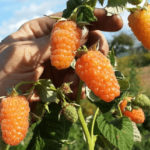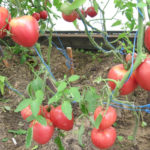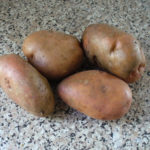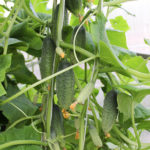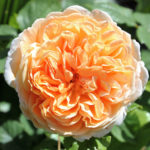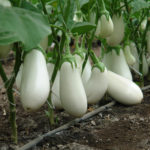Pear variety Moskvichka
Moskvichka is an autumn pear variety of the Moscow Agricultural Academy named after V.I. K.A. Timiryazeva, isolated from seedlings from free pollination of the Kiffer variety. The authorship is assigned to S.T. Chizhov and S.P. Potapov. The variety is zoned in the Central, Volgo-Vyatka and Middle Volga regions. Widespread in the Moscow region.

The trees are of medium size and belong to the standard type. The crown is dense, medium-leafy, funnel-shaped in shape at a young age, conical in the period of full fruiting. The bark on a trunk is gray. Skeletal branches are obliquely vertical and are light gray. Ringworms are sessile. The kidneys are characterized by above-average awakening. The ability to form shoots is average.
Shoots of medium length and thickness, curved, in cross section - rounded, brown in color, not pubescent, internodes of medium length. Lentils are small in size, convex in shape, on the shoots are present in an average amount. Buds are dark brown in color, deviated, conical in shape. The leaves are medium in size, green in color, oval in shape, with serrated edges. The leaf blade is of medium thickness, elastic (leathery), with a curvature along the central vein, smooth, lint-free, both on the upper and lower sides. Petioles are of medium length.
The flowers are non-double, medium-sized, cupped in shape, the corolla is white. Inflorescences of the corymbose type (racemose), formed from 5 - 7 flowers. White buds. Flowering occurs in the late period.
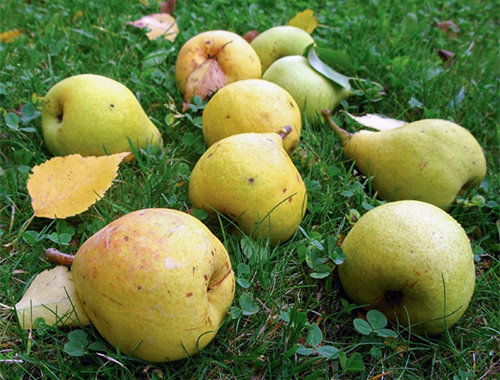
The fruits of the Moskvichka pear are of average size (average weight is 120 - 130 grams) and a wide pear-shaped form. The size of the fruit is uneven. The skin is greenish-yellow, the integumentary color is expressed in the form of a faint blush or is completely absent. Numerous small subcutaneous points are visible on the surface of the fruit. The skin is often heavily rusty in the form of irregular spots. There is no funnel. A saucer of small size, wide, slightly ribbed.
The pulp has a white color and a dense semi-oily structure; it is granular near the heart. The taste is very good: pears are sweet and sour, melting, very juicy and incredibly fragrant. By chemical composition, the fruits contain: dry substances (16.2%), soluble substances (13.1%), the amount of sugars (9.5%), acids (0.48%), P-active substances (220 mg / 100 g). A variety of dessert type. The purpose of the fruit is universal.
In terms of ripening, the variety is autumn: harvesting is carried out from the beginning to the end of September, depending on what the year turned out to be. A slight yellowing of the skin of the fruit against a green background indicates their ripeness. Fruits are stored for a long time at 0 ° C - up to 2.5 - 3 months (maximum keeping quality reaches 80 - 100 days). In room conditions, the total storage period does not exceed 2 weeks, after which the pears begin to deteriorate. To preserve the fruits as long as possible, it is recommended to pluck them early, without waiting for signs of yellowness, and store them exclusively in the refrigerator. Fruit shedding is weak. Transportability is average. The commercial qualities are high.
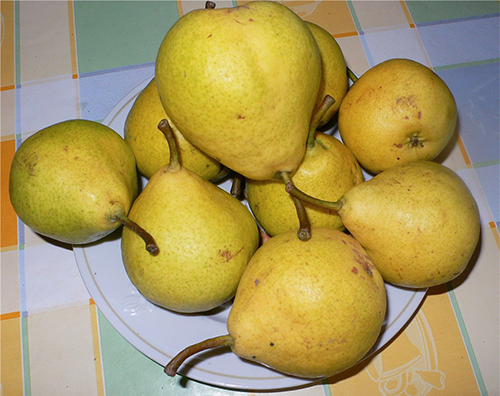
The Muscovite belongs to self-fertile pears. The best pollinators can be varieties: Bergamot Moskovsky and Lyubimitsa Yakovleva.
The early maturity of this pear is good, the trees begin to bear fruit from the 3rd - 4th year after planting. Fruiting is annual. The yield is above average, one tree gives up to 35 - 40 kg of fruit. Average winter hardiness. It should be noted that the variety is highly resistant to extreme weather conditions and diseases. Resistance to scab and fruit rot is quite high.
The main advantages of the Moskvichka pear are: early maturity, high commercial and consumer qualities of fruits, regular fruiting (even in unfavorable years), good yield, a sufficient level of winter hardiness for Central Russia and good disease resistance.
For planting seedlings, it is advisable to choose sunny places. Although the variety is undemanding to soils, fertile and well-drained soil is preferable. When caring for trees, it is important to avoid excessive waterlogging of the soil and moisture stagnation.
